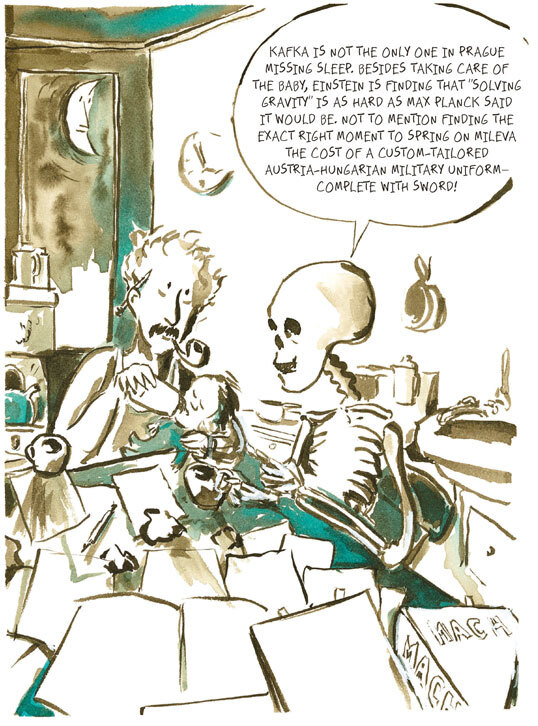A Year that Changed Everything
By Jaime Herndon
An excerpt from the new graphic narrative from Ken Krimstein, Einstein in Kafkaland: How Albert Fell Down the Rabbit Hole and Came Up with the Universe.
An excerpt from the new graphic narrative from Ken Krimstein, Einstein in Kafkaland: How Albert Fell Down the Rabbit Hole and Came Up with the Universe.

Einstein in Kafkaland: How Albert Fell Down the Rabbit Hole and Came Up with the Universe. Ken Krimstein. 224 pp. Bloomsbury, 2024. $32.00.


Excerpted with permission from Bloomsbury Publishing Inc. from Einstein in Kafkaland: How Albert Fell Down the Rabbit Hole and Came Up with the Universe. © by Ken Krimstein, 2024.
Einstein in Kafkaland: How Albert Fell Down the Rabbit Hole and Came Up with the Universe is the newest graphic narrative by Ken Krimstein, a cartoonist, author, and teacher. Krimstein focuses on one year in Prague—from April of 1911 to July of 1912—when both Albert Einstein and Franz Kafka lived there. The two men would often see each other at the famous literary salons hosted by poet Berta Fanta, gatherings that would come to be known for attracting notable intellectuals.
Einstein had moved from Zurich to Prague with his first wife, Mileva Maric´, and their three children for a professorship in theoretical physics at Charles University. At that time, Kafka was far from being the novelist we know today: He was an insurance executive still living at home with his parents at the age of 28.
The two men would often see each other at the famous literary salons hosted by poet Berta Fanta, gatherings that would come to be known for attracting notable intellectuals.
By July 1912, Einstein left Prague and returned to Switzerland to teach at ETH Zurich. Earlier that year he published work on static gravitational fields, or what he termed “solving gravity.” By the end of that same year, Kafka finished his short story “The Judgement,” a tale that is often cited as being his “breakthrough,” and the one that defined his writing style.
Krimstein’s book is a genre-bending hybrid of fact and fiction, taking liberties with some history while also adding fantastical elements, all depicted in a dreamlike style of mostly black and white sketches, with pops of teal. Taking from diaries, lectures, letters, and papers from this period, he writes about both Einstein and Kafka’s work and their lives, while showing how their seemingly separate paths converged and were actually quite similar.
Click "American Scientist" to access home page
American Scientist Comments and Discussion
To discuss our articles or comment on them, please share them and tag American Scientist on social media platforms. Here are links to our profiles on Twitter, Facebook, and LinkedIn.
If we re-share your post, we will moderate comments/discussion following our comments policy.